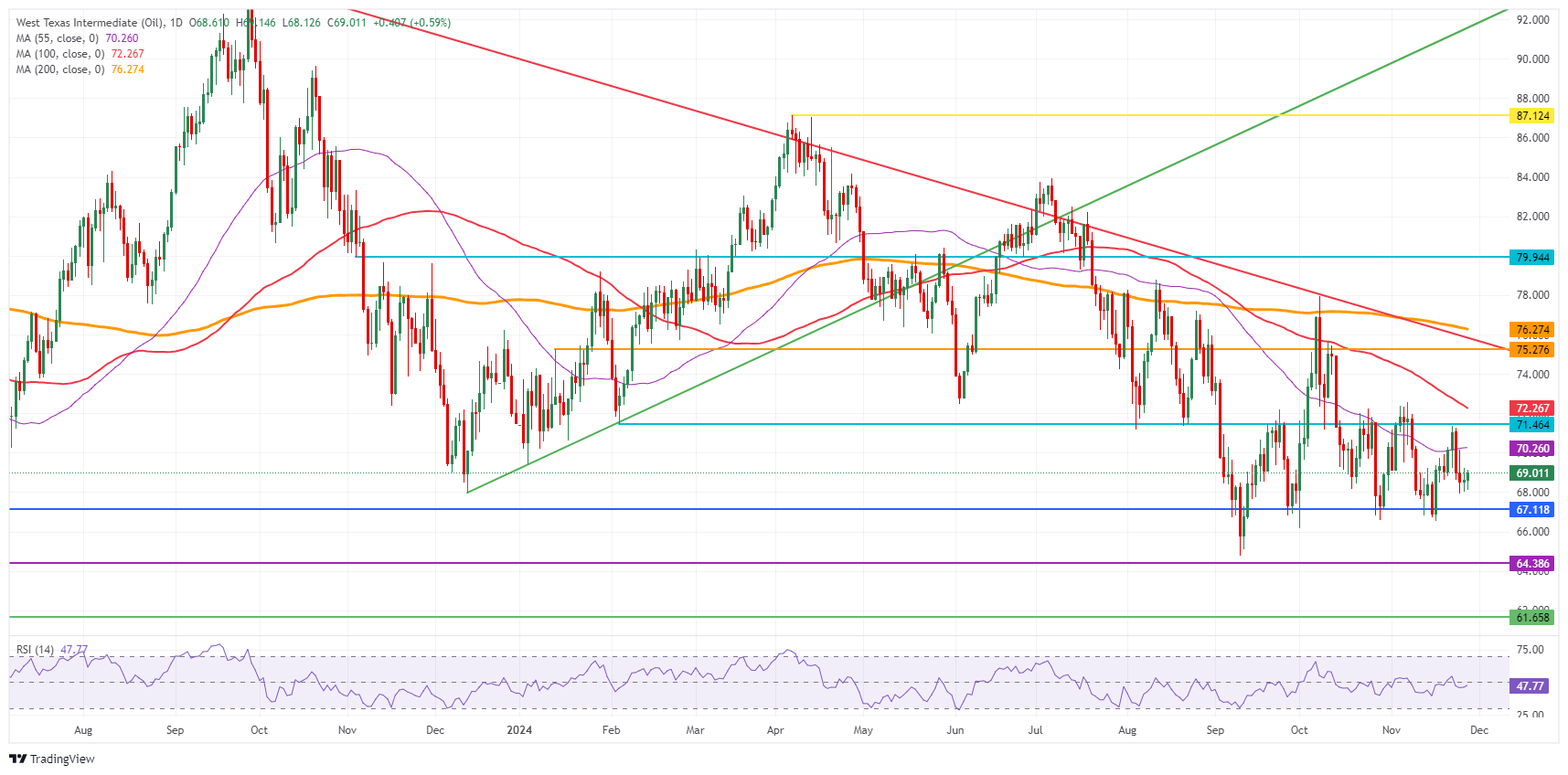- Headlines spark on Thursday with Israel possibly having breached the recent ceasefire deal already after one day.
- OPEC+ has moved the Output Policy Meeting to December 5, for an in-person meeting.
- The US Dollar Index bounces off support with US markets closed for Thanksgiving.
Crude Oil falling flat, and is returning less than 0.50% profit on this Thursday after headlines that Israel has already broken the ceasefire deal between in the Gaza region, Bloomberg reports. Meanwhile, the Organization of the Petroleum Exporting Countries and its allies (OPEC+) have confirmed they will postpone its upcoming Output Policy Meeting decision from Sunday to December 5. The conglomerate of Oil producers and exporters is again facing an existential crisis, with a slowdown in global demand with more non-OPEC supply to be released to markets taking place.
The US Dollar Index (DXY), which measures the performance of the US Dollar (USD) against a basket of currencies, is bouncing off a technical support level. With US markets closed on Thursday and Friday for Thanksgiving and Black Friday, the bounce of the DXY comes from Europe, where France is facing issues. The French Prime Minister Michel Barnier warned that France could become unstable if the French Parliament does not pass the much-needed budget plan, which could cause issues for France in financial markets, Bloomberg reported.
At the time of writing, Crude Oil (WTI) trades at $68.76 and Brent Crude at $72.54
Oil news and market movers: North Sea Loadings drop
- North Sea loadings are scheduled at around 587,000 barrels per day for January, the lowest leve since October, according to Bloomberg data.
- As Thursday evolves, headlines emerged that Israel has still executed some tactital moves in the Gaza and Lebanon region, potentially breaking the ceasefire deal, Bloomberg reports. Israel came out saying that is involved specific targets which were not part of the ceasefire negotiations.
- Delegates close to the matter confirmed in early Thursday trading that OPEC+ will delay its planned meeting for Sunday towards December 5, Reuters and Bloomberg reported. OPEC’s secretariat said that the delay was because several ministers will attend the meeting of the Gulf Cooperation Council in Kuwait on Sunday.
- China’s independent refiners have snapped up barrels from across the Middle East and Africa as offers of Iranian Oil remain scarce and are more expensive due to broadening US sanctions, Bloomberg reports.
- Israel has warned residents displaced by fighting and evacuation orders not to return to their homes in southern Lebanon, despite a ceasefire between Israeli forces and Hezbollah coming into effect Wednesday, CNN reports.
Oil Technical Analysis: Gridlock and oversupply main themes for Oil
Crude Oil price still faces selling pressure as traders become impatient about what OPEC+ will do to support Crude Oil prices. With the slowdown in the Chinese economy, a global slowdown in Oil demand, and the US set to pump and dump many more barrels under President-elect Donald Trump, the rabbit that OPEC+ will need to grab out of its magic hat must be an impressive one. Keep in mind that, with plenty of stop orders placed just below $67.00, a quick correction to $66.00 or even $64.00 could be a possible scenario.
On the upside, the pivotal level at $71.46 (February 5 low) and the 100-day Simple Moving Average (SMA) at $72.26 are the two main resistances. The 200-day SMA at $76.27 is still far off, although it could be tested if tensions intensify further. In its rally towards that 200-day SMA, the pivotal level at $75.27 (January 12 high) could still slow down any upticks.
On the other side, traders need to look towards $67.12 – a level that held the price in May and June 2023 – to find the first support. In case that breaks, the 2024 year-to-date low emerges at $64.75, followed by $64.38, the low from 2023.
US WTI Crude Oil: Daily Chart
Brent Crude Oil FAQs
Brent Crude Oil is a type of Crude Oil found in the North Sea that is used as a benchmark for international Oil prices. It is considered ‘light’ and ‘sweet’ because of its high gravity and low sulfur content, making it easier to refine into gasoline and other high-value products. Brent Crude Oil serves as a reference price for approximately two-thirds of the world's internationally traded Oil supplies. Its popularity rests on its availability and stability: the North Sea region has well-established infrastructure for Oil production and transportation, ensuring a reliable and consistent supply.
Like all assets supply and demand are the key drivers of Brent Crude Oil price. As such, global growth can be a driver of increased demand and vice versa for weak global growth. Political instability, wars, and sanctions can disrupt supply and impact prices. The decisions of OPEC, a group of major Oil-producing countries, is another key driver of price. The value of the US Dollar influences the price of Brent Crude Oil, since Oil is predominantly traded in US Dollars, thus a weaker US Dollar can make Oil more affordable and vice versa.
The weekly Oil inventory reports published by the American Petroleum Institute (API) and the Energy Information Agency (EIA) impact the price of Brent Crude Oil. Changes in inventories reflect fluctuating supply and demand. If the data shows a drop in inventories it can indicate increased demand, pushing up Oil price. Higher inventories can reflect increased supply, pushing down prices. API’s report is published every Tuesday and EIA’s the day after. Their results are usually similar, falling within 1% of each other 75% of the time. The EIA data is considered more reliable, since it is a government agency.
OPEC (Organization of the Petroleum Exporting Countries) is a group of 12 Oil producing nations who collectively decide production quotas for member countries at twice-yearly meetings. Their decisions often impact Brent Crude Oil prices. When OPEC decides to lower quotas, it can tighten supply, pushing up Oil prices. When OPEC increases production, it has the opposite effect. OPEC+ refers to an expanded group that includes ten extra non-OPEC members, the most notable of which is Russia.
Information on these pages contains forward-looking statements that involve risks and uncertainties. Markets and instruments profiled on this page are for informational purposes only and should not in any way come across as a recommendation to buy or sell in these assets. You should do your own thorough research before making any investment decisions. FXStreet does not in any way guarantee that this information is free from mistakes, errors, or material misstatements. It also does not guarantee that this information is of a timely nature. Investing in Open Markets involves a great deal of risk, including the loss of all or a portion of your investment, as well as emotional distress. All risks, losses and costs associated with investing, including total loss of principal, are your responsibility. The views and opinions expressed in this article are those of the authors and do not necessarily reflect the official policy or position of FXStreet nor its advertisers. The author will not be held responsible for information that is found at the end of links posted on this page.
If not otherwise explicitly mentioned in the body of the article, at the time of writing, the author has no position in any stock mentioned in this article and no business relationship with any company mentioned. The author has not received compensation for writing this article, other than from FXStreet.
FXStreet and the author do not provide personalized recommendations. The author makes no representations as to the accuracy, completeness, or suitability of this information. FXStreet and the author will not be liable for any errors, omissions or any losses, injuries or damages arising from this information and its display or use. Errors and omissions excepted.
The author and FXStreet are not registered investment advisors and nothing in this article is intended to be investment advice.
Recommended content
Editors’ Picks

AUD/USD ticks lower toward 0.6200 after Australian Nov inflation data
AUD/USD remains pressured toward 0.6200 following the release of Australian consumer inflation figures, which showed a slowing in the trimmed mean annual CPI , boosting the odds for an April RBA rate cut. Meanwhile, US-China trade war fears and a softer risk tone add to the weight on the pair.

USD/JPY steadies at around 158.00, Fed Minutes awaited
USD/JPY holds steady at atound the 158.00 mark early Wednesday amid uncertainty over further BoJ rate hikes. Further, the Fed's hawkish shift, the recent surge in the US bond yields and a bullish US Dollar support the currency pair, though Trump trade risks cap gains. US ADP data and Fed Minutes eyed.

Gold consolidates near $2,650 amid mixed cues; looks to Fed Minutes
Gold price stabilizes near $2,650 after the pullback from the $2,665 barrier as concerns about Trump's tariff plans and geopolitical risks support the safe-haven bullion. That said, diminishing odds for further Fed rate cuts and elevated US Treasury bond yields-led US Dollar strength weigh on Gold price ahead of Fed Minutes.

Crypto market surged to $3.9 trillion record market cap as Solana's revenue plunged in December: Binance
In a report on Monday, Binance Research stated that the crypto market reached a market capitalization milestone of $3.9 trillion in December. The researchers suggest anticipation surrounding Donald Trump's upcoming pro-crypto administration could stretch the bullish momentum in the coming weeks.

Five fundamentals for the week: Nonfarm Payrolls to keep traders on edge in first full week of 2025 Premium
Did the US economy enjoy a strong finish to 2024? That is the question in the first full week of trading in 2025. The all-important NFP stand out, but a look at the Federal Reserve and the Chinese economy is also of interest.

Best Forex Brokers with Low Spreads
VERIFIED Low spreads are crucial for reducing trading costs. Explore top Forex brokers offering competitive spreads and high leverage. Compare options for EUR/USD, GBP/USD, USD/JPY, and Gold.
